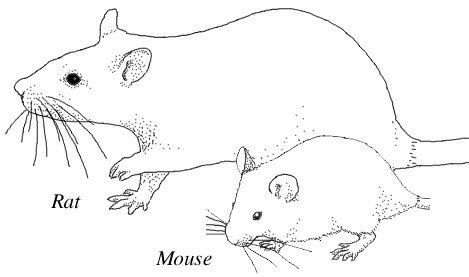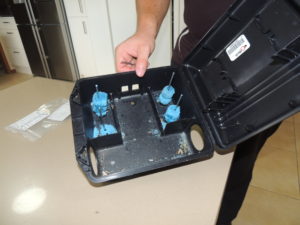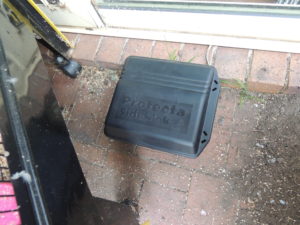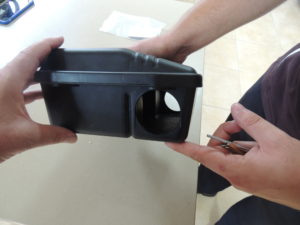Mice Control in Sydney - Residential And Commercial

“I’ve dealt with many properties that struggle with mouse control and never found a premises which couldn’t be treated by our professional team with outstanding results. Our testimonies speak for themselves!” – A1 Team
The presence of mice is undesirable in any commercial premises however, if the complex houses businesses that serve, prepare or store food, it’s usually necessary to ensure you have a mice control plan in place. It’s not just restaurants and shopping centres that generally need to do this –
complexes such as hospitals, schools and hotels also have food preparation and storage areas.
House Mouse – Mus Musculus
15-30g 6-10cm plus tail about as long as body. Fur fine, colour brown to grey. Skull 6mm high, large ears, pointed snout. Droppings 3-4mm, pointed
Prolific breeder in conducive conditions. Female mates at 6-10 weeks, gestation period 3 weeks 5-6 pups per litter. Pups small blind pink and hairless. Female produces 6-10 litters spaced 30-50 days apart. Young weaned at 3 weeks. Mice live 1-2 years
Secretive opportunistic curious, unpredictable and erratic feeding behaviour. Only rodent species found throughout Australia. Generally lives outdoors but adapts readily to living indoors.
Nibble at multiple locations.
Can live and breed without free water if the moisture content of the food is at least 15%.
Known to travel 2km to seek food and shelter, normal range is 3-10m.
Mouse plagues occur in grain-growing areas about every 4 years with numbers up to 3,000 mice per hectare.
Plagues only occur in Australia and China. Damage from gnawing, to packaging.
Contamination from urine and faeces much greater than what they consume.
Mice Control Sydney- How To Get Rid of That Rodent Nuisance
There are a variety of treatment options available to Australian homes that want to rid themselves of any rodent infestation. During winter rodent activity increases substantially as mice seek out warmer nesting areas which often ends up with them infesting homes or offices!

Treatment Strategies Include:
Baiting
This is the most effective treatment method for getting rid of mice and it is our recommended treatment option to get a positive long term effect. With baiting you also don’t need to worry about seeing a gory mess as you would when using mouse traps. With our Rodent Baiting Systems you don’t need to worry about any messy residue, nasty smells or annoying mice! After ingesting the bait results are achieved anywhere from as little as 4 hours.

Traps
There are lots of different mice traps currently on the market but they all have similarities and generally work on the same premise (snapping down on the mouse/rat) and leaving quite a mess that would require a strong stomach to clean up.
Fumigation
This treatment method is generally only used in agricultural settings for the treatment of large silos and due to using an airborne pesticide results are achieved very quickly over a large surface area.
Mice & Disease
Mice and other rodents are well known disease carriers. Perhaps the most famous disease carried by rodents is the Bubonic Plague (also called the ‘Black Death’) which has killed millions and millions of people over the centuries. The disease is passed to humans by fleas that have been in contact with infected rats or mice, and then from human to human as symptoms develop. Europe, the United Kingdom and even Australia were affected by outbreaks in the 1900s. Although the disease still exists, such massive outbreaks are unlikely in this day and age in Australia thanks to
general improvements in hygiene standards, the availability of pest control, better medical facilities and antibiotics!
Weil’s disease (also known as Leptospirosis) isn’t such ancient history – in fact, Andy Holmes, an Olympic rower, passed away after contracting this disease as recently as 2010. How did he get it? This disease can be picked up by coming into contact with water that has been contaminated by rodents.
Salmonella bacteria are also spread by mice. Many people think that Salmonella comes from consuming food that is ‘off’ however, that’s not the case at all.
The Salmonella bacterium is passed only from an infected animal. Frequently it occurs when droppings of an infested mouse, mice or other vermin comes into direct contact with your food.
Or sometimes even when food isn’t cooked throughout from an animal with an existing infestation.
It can also be passed on or transmitted by human hands and by utensils – for example, when someone touches or cuts a raw product that is contaminated, and then touches food that is ready to eat with contaminated hands, or the contaminated knife.
That’s just a sample of the diseases that mice and rats can carry and transmit. The symptoms of all of these illnesses are quite serious and can be fatal, particularly in those whose health may be weakened by another condition – so the control of mice and rats in the vicinity of areas inhabited or frequented by humans is absolutely vital.

Where do rodents hide?
Household rodents can live in hidden areas such as roof-spaces, wall cavities, behind cupboards, underneath countertops, near furnaces, in the laundry, near pet areas, in basements, and in crawl spaces. If rodents are found in your house it does not automatically mean your hygiene is poor, since they might simply have been attracted to your pet feed, bird seed, or scraps you feed to wild birds or your chickens (if you keep them).
Tell-tale signs of rodents include droppings, urine stains, smear marks on walls, odours, noises at night in your attic or walls, and gnaw marks in beams or furnishings.
Mice control is recommended even for commercial premises that don’t house food related operations because if buildings and properties nearby have strict pest and rodent control measures in place, an unprotected building may be the most attractive destination for the local mice!
If you’d like to speak to an expert about commercial mice control in the greater Sydney region, call Bruce Gow today on 0417 251 911 for a prompt assessment and quote. Or email us directly at bruce@a1pestcontrol.com.au
